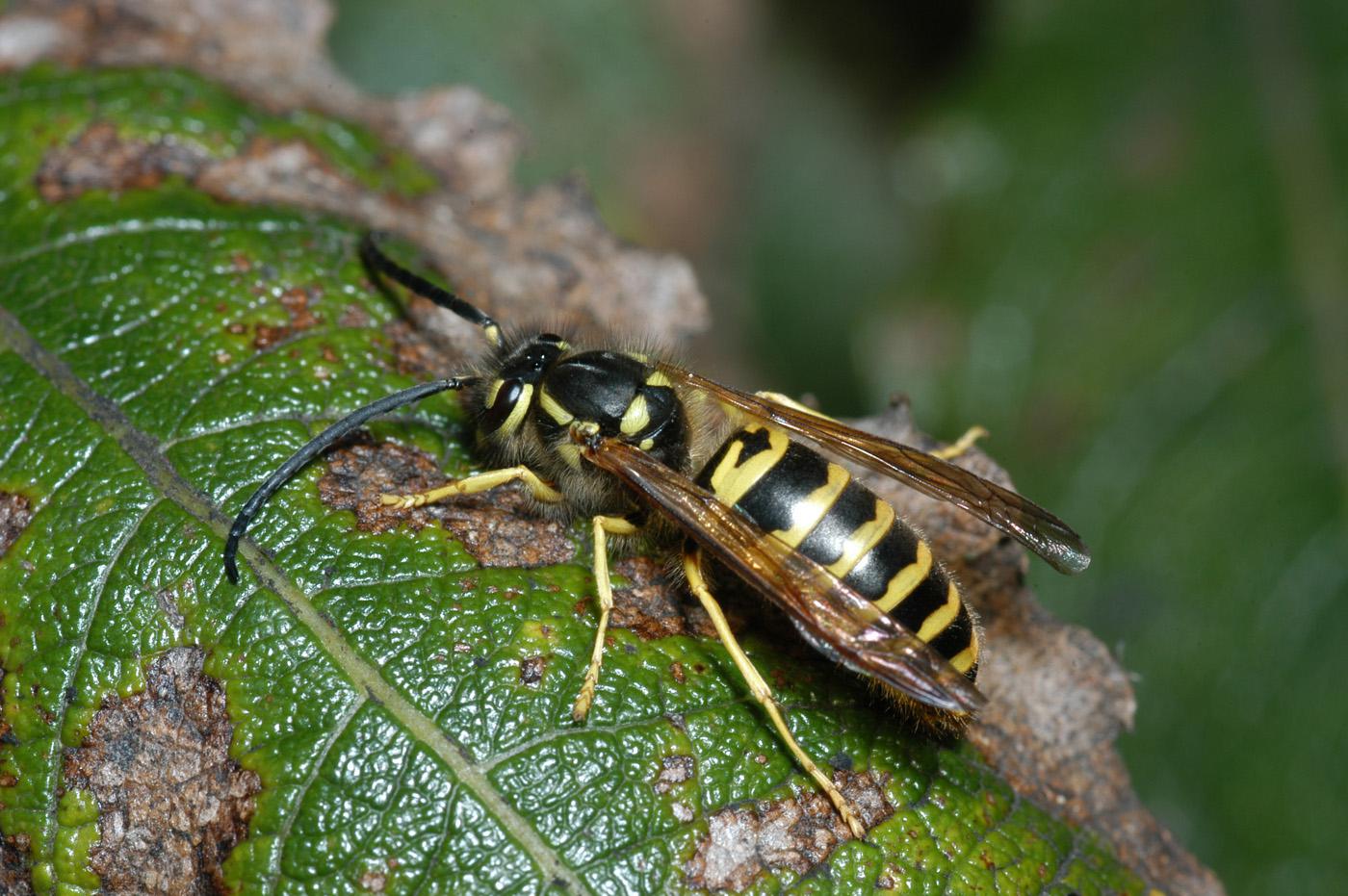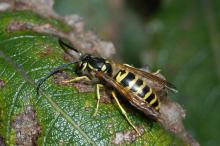Information Possibly Outdated
The information presented on this page was originally released on August 19, 2010. It may not be outdated, but please search our site for more current information. If you plan to quote or reference this information in a publication, please check with the Extension specialist or author before proceeding.
Yellow jackets attack to protect home nests
MISSISSIPPI STATE – Yellow jackets are most likely to attack in the fall, but these stinging wasps are a year-round threat, especially because they can be hard to detect until they are disturbed.
Yellow jackets are small wasps about 3/8 inch long. Their black and yellow-banded bodies have three segments. Each insect is equipped with a smooth stinger that can sting multiple times. In contrast, a honey bee has a barbed stinger that stays in the wound, limiting the bee to only one sting.
Blake Layton, an entomologist with the Mississippi State University Extension Service, said yellow jackets build a new nest each year. They start in the spring as a single, founding queen, but by fall, a nest can contain hundreds of workers.
“When they are disturbed, they come out in numbers and are very defensive of their nest,” Layton said. “They don’t go looking for people to sting, but if they sense their nest is threatened, they attack in mass.”
Sounds and vibrations, such as a lawnmower moving over an underground nest or children playing nearby, disturb yellow jackets and trigger attacks.
The two species in Mississippi are the Southern yellow jacket and the Eastern yellow jacket. Both nest in colonies in the ground, although they have been known to nest between bales of hay or in walls or anywhere they can find a dark void, such as in items stored in a barn or attic.
“If you dig one of these nests up, you’ll find it is a bulky, multi-tiered paper nest. Most are the size of a soccer ball by the end of the year, but some can be larger,” Layton said.
Layton said the best thing to do when being attacked by yellow jackets is to get away as quickly as possible. A 50-yard buffer should be enough.
“They chase, so you have to move far enough away from their nest,” Layton said.
Jane Clary, MSU Extension health specialist, said each person responds differently to stings.
“Stings hurt everyone, but for some people, a sting is a life-threatening situation because they go into anaphylactic shock,” Clary said. “A person having an allergic reaction needs emergency treatment. An EpiPen can aid their breathing until they can get to an emergency room.”
It is wise to take an antihistamine immediately after a sting to help reduce allergic symptoms. Anaphylaxis is a serious, potentially life-threatening allergic response marked by swelling, hives, lowered blood pressure and dilated blood vessels. A person can have difficulty breathing, and in severe cases, will go into shock and can die if untreated.
Clary said ice and a topical sting ointment applied to the wounds can help ease pain and swelling. If the person is not having difficulty breathing and is not showing signs of anaphylactic shock, medical attention is needed only if the sting site becomes hot to the touch, red or weepy.
But prevention is better than running away when an attack is under way. Layton urged everyone to be aware of their surroundings, and when two or three yellow jackets are spotted in an area, look for a nest.
“If you see air traffic, that’s the key indicator that there may be a yellow jacket nest nearby,” Layton said. “They are fairly subtle, so you may have to look very carefully.”
When a yellow jacket nest is located, wait until dark to get rid of the pests.
“They don’t fly as readily after dark, so that’s a good time to do the treatment,” Layton said. “At night, you can slip up on yellow jacket and bumblebee nests without disturbing them.”
The entomologist said the easiest way to kill a yellow jacket nest is to pour a tablespoon of an insecticide dust that contains deltamethrin over the entrance of the nest at night.
“Take a 3-4 foot long stick and tape a cup on the end of it. Put the insecticide powder in the cup, then tip it over the nest while keeping my distance,” Layton said.
Depending on the size of the nest, this insecticide may have to be applied two or three times. The goal is to place the powder over the entrance so the yellow jackets get it on their bodies as they travel into the nest. This method usually takes a few days to work, but if done properly, it is non-confrontational and reduces the chance of being stung.
Yellow jackets also can be killed with aerosol wasp sprays. Although such sprays will quickly kill the insects they contact, it can be difficult to reach all the insects in the nest.
Another sure way to kill yellow jackets is to just wait for cold weather to set in. Only the queens survive the winter, usually by leaving the nest and sheltering in a protected place such as an attic, hollow tree or under the bark of a dead tree. In the spring, the queen starts a new, small paper nest in a void she has found in the ground.




